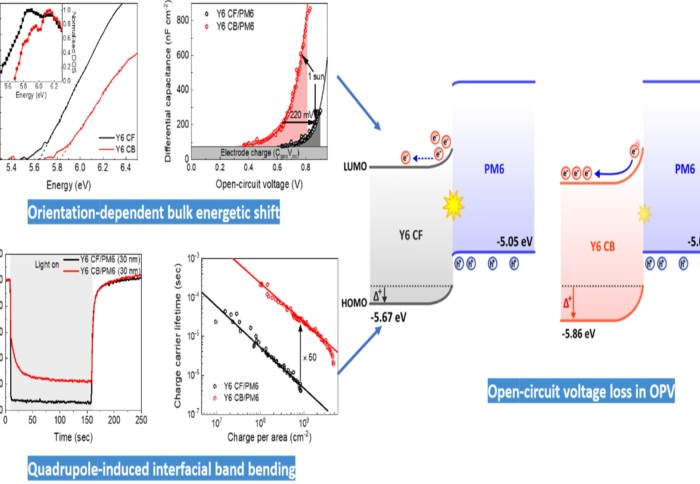Orientation of Organic Semiconductors Determines Interfacial Energetics!
by Lisa Bushby

Using molecular orientation to control device energetics
CPE researchers in collaboration with Samsung Electronics have unveiled how interfacial energetics can be controlled through molecular orientation.
Solar cells made from solution-processable organic semiconductors have gained significant attention due to their unique advantages including flexibility, printability, colour tunability, and low cost, as well as their potential for indoor applications. Since non-fullerene acceptors (NFA) were introduced, the efficiency of bulk-heterojunction organic solar cells (OSC) has been rapidly increased up to 19%. However, low open-circuit voltage (VOC) of OSCs still limits the efficiency to be much lower than the theoretical maximum of 25%. Although, to the first approximation, the VOC is determined by the energy level offsets between donor and acceptor materials, there has been a strong debate in the OSC community on the origin of VOC losses. Therefore, understanding the interfacial energetics at the donor-acceptor heterointerface is the key to identify the origin of VOC losses and to further improve the efficiency of OSCs.
Researchers at Imperial College London, in collaboration with Samsung Electronics, have unveiled how this interfacial energetics is controlled simply by the molecular orientations. They have demonstrated a significant energetic shift (> 200 meV) depending on the molecular orientation of Y6, a state-of-the-art NFA, in the film, switching from face-on to more edge-on orientation, which is assigned to the large molecular quadrupole moments of Y6 affecting its electrostatic potential. They have identified the impact of such energetic shift on OSC performance. The larger quadrupole-induced interfacial band bending assists better charge separation, leading to the changes in effective electronic bandgap and internal quantum efficiency of both planar bilayer and blended bulk-heterojunction devices.
This work is of great interest to many of those within the organic photovoltaic community. It highlights the importance of molecular orientations which determine interfacial energetics, photophysical processes, and hence OSC device performance. By controlling molecular quadrupole moments via changes in the chemical structure and fine-tuning of the thin film morphology, both energetics and recombination kinetics could be optimized to further improve the VOC of OSCs while maintaining high efficiency charge generation. This study also provides the important information to the community regarding the origin of VOC losses and different OSC device performances using the same materials often reported in the literature.
Fu, Y., Lee, T.H., Chin, YC. et al. Molecular orientation-dependent energetic shifts in solution-processed non-fullerene acceptors and their impact on organic photovoltaic performance. Nature Communications 14, 1870 (2023). https://doi.org/10.1038/s41467-023-37234-0
Article text (excluding photos or graphics) © Imperial College London.
Photos and graphics subject to third party copyright used with permission or © Imperial College London.
Reporter
Lisa Bushby
Department of Physics